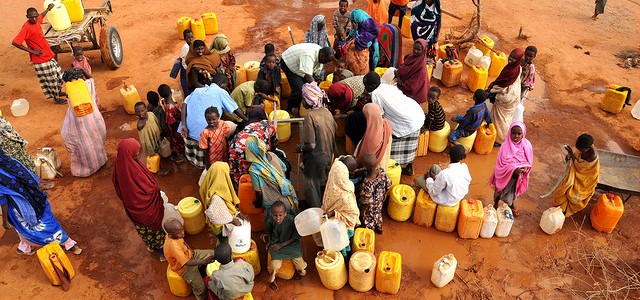Characteristics
The first step towards understanding water endowments is to assess water demand and supply in a particular spatial unit. The quantity and quality of water resources need to be determined and the parameters of the hydrological cycle identified. These can then be related to the identified consumption patterns and predictions. This allows decision makers to contrast the competing uses of water with the physical resource base, make assessments of the balance and adequacy between resource endowment and consumption in order to assess different development alternatives for their feasibility in regards to water supply and demand balance over a particular time period being considered. This is a way of integrating considerations regarding water security into development planning.
Water supply, as well as demand, can be assessed on different scales, e.g. for a catchment, sub-catchment, irrigation district, municipal area or groundwater reservoir. It encompasses the resources that are utilised as well as the system that conveys the water to the point of consumption. Depending on the objective, the analysis may look at a range of physical, chemical and biological features in determining the dynamics of the resource. Those features should include the hydrological cycle, timescale and the physical processes it involves – i.e. evaporation, condensation, precipitation, infiltration, runoff, and subsurface flow.
In order to obtain information on water resources in an area, consultations with local water authorities, water providers and other appropriate sources are helpful. The same goes for available studies or literature on water resources in a spatial unit. Again, this also includes material on water quality, land use and land management. Where such material exists, it needs to be reviewed and taken into account when assessing the ability of the resources to provide an adequate water supply. Where no such material exists, strategic points for monitoring water quality should be identified and water samples taken and analysed.
Especially when evaluating ground water, hydrogeological data plays a big role, such as the nature of the local bedrock and surface geology, including stratigraphy, thickness, composition, and texture. Known relevant weathering/alteration/structural features such as joints, fractures, faults, or bedding planes can provide important information on how water travels from the surface into ground water aquifers. The water-bearing potential of the groundwater unit is also of relevance.
On the demand side, decision makers have to know how much water is used, for what purposes, the patterns of usage and how that water is returned to the environment. Demand assessment examines how water is consumed, for what purposes, what influences patterns of consumption, the drivers of demand, losses and non-revenue water and the impact of price and tariff policies. The later helps to determine the financial resources available for water resource management.
Demand forecasting uses techniques that examine, for example, the willingness to pay for water at given prices and can then use those results for sustainable planning. An analysis of user behaviour, elasticity of demand, and the potential effects of demand management helps with that. A common difficulty with demand forecasts is that they are often based solely on the use of historic data including past population growth. The question of time horizon is an important consideration. Whilst for short to medium term demand, historic data may be a reasonable basis for projections, the implicit assumptions of stationarity do not hold for longer term projections. Therefore, planners often end up with figures that don’t match future demand. Other aspects to consider are urbanisation trends, land use trends, local GDP, and so on.
To get the full picture on supply and demand, it is important that socio-economic factors influencing human water consumption are also included. A thorough evaluation how changes in future demand might lead to major water resources issues can help in pinpointing potential conflicts, as well as their severity and social implications (see C2.03). The same can be said for hazards such as flood and drought and the impacts on the environment caused by human demand for water resources (see Tools C2.01; C2.04).
Once water supply and demand have been analysed, they can be compared against each other and used for evaluating water management alternatives. This is usually done in four steps:
1. Determine water supply needs – subtract projected future demands on water from existing, firm water supplies for a specific spatial area (if there are shortfalls within the period of analysis then move to the next step)
2. Identify potential new water supply alternatives including conservation – list individual projects or combinations of projects that could be implemented; for these, collect data on supply yield, cost, water quality, environmental impacts, and other relevant information
3. Rank options – develop and weigh evaluation criteria that best define a project’s mission and goals. Then for each supply alternative, calculate performance scores and rank the alternatives according to this performance
4. Select water supply alternative – compare the ranking of alternatives to the water supply needs in order to determine the priority for implementation
Lessons learned
- An assessment of demand and supply often needs to be carried out in several steps of increasing complexity. A rapid assessment may help identify and list the areas where demand and supply are the most divergent and thus help identify the most important issues and priority areas. On the basis of this early assessment, more detailed investigations may be required.
- Evaluations of large or long-term projects need to include examination of changes in land use and possible soil degradation as well as climate variability.
- Linking analyses of demand and supply to environmental or ecosystem assessments has been shown to build cross-sectoral linkages and heighten awareness of key issues.
- Strategic impact assessment can help in the analysis of change capacity of a river basin, to protect both quantity and quality.
- Before looking at developing new water sources, it is a cost-effective strategy to look towards improving water demand management (e.g. by reducing leakages and bursts, recycling and reusing water – C6.03)

